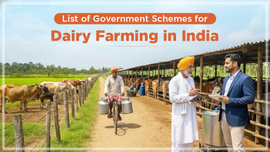GOBARDhan Scheme: A Holistic Approach Towards Crop Residue Management in India

GOBARDHAN is a comprehensive umbrella initiative of the Indian government that covers all aspects of waste management and aims to convert waste to wealth to promote a circular economy. The primary objective of this scheme is to protect the environment from air pollution and prevent the loss of nutrients and soil micro-organisms caused by the burning of crop residues. Its thorough approach reassures us of its effectiveness in addressing these pressing issues.
Table of Content
- Introduction
- What are the objectives of the GOBARDhan Scheme?
- What benefits does GOBARDhan Scheme provide to farmers?
- What are the eligibility criteria for the GOBARDhan Scheme?
- Documents Required for GOBARDhan Scheme
- How to apply for the GOBARDhan Scheme?
- Conclusion
Introduction
The Galvanizing Organic Bio-Agro Resources Dhan (GOBARDhan) scheme was launched in April 2018 by the Ministry of Drinking Water & Sanitation. It is a part of the Solid and Liquid Waste Management component under the Swachh Bharat Mission (Grameen). Its main motive is to keep the villages clean, improve rural income and produce energy and organic manure from cattle and organic waste. Since rural India has already got the status of Open Defecation Free (ODF), the importance of the GOBARDhan scheme has increased as it supports the villages in getting ODF-plus status, which is an essential aim of Swachh Bharat Mission (Grameen) Phase II.
What are the objectives of the GOBARDhan Scheme?
- It supports farmers in managing their cattle and organic waste, agricultural waste/residue, etc. and keeps the village clean.
- It helps generate livelihood in rural areas and improves farmers' income by assisting them in converting their organic waste to wealth through the production of manure and energy out of waste.
- It helps protect the environment from air pollution and prevent the loss of nutrients and micro-organisms caused by the burning of crop residues.
- It promotes crop residue management by retention/incorporation into the soil and making a proper supply chain for further utilization through developing proper mechanization inputs.
- It creates awareness among stakeholders through demonstration, education and communication strategies, capacity-building activities and differentiated information to use and manage the crop residues effectively.
What are the eligibility criteria for the GOBARDhan Scheme?
- Individual households recognized by the Gram Panchayats are eligible for this scheme under the individual household model.
- A cluster of households recognized by the gram panchayats, associated with cooperatives, Farmer Producer Organizations (FPOs), Milk Unions, SHGs, Private entrepreneurs, and CBOs developed under DAYNRLM are eligible for the cluster model. However, there must be three to four cattle in these households.
- Households recognized by Gram Panchayats are eligible for the community model.
- Cooperatives/Entrepreneurs/Dairies/Gaushalas, etc., are eligible to establish large biogas/CBG plants.
- Farmers with high cattle production are considered to be a priority.
What benefits does GOBARDhan Scheme provide to farmers?
- It helps in the management of a large portion of solid waste in the villages, such as agricultural wastes and cattle dung, and supports environmental sanitation.
- It helps minimize greenhouse gas emissions and supports environmental sustainability.
- It helps in reducing vector-borne diseases and supports public health.
- It helps produce organic manure, which improves farm productivity.
- It supports household income and savings as using biogas reduces the expenditure on LPG.
- It also supports income generation and employment opportunities for SHGs/farmers' groups.
- It helps save foreign exchange by limiting the need to import natural gas.
How to apply for the GOBARDhan Scheme?
Farmers can submit the application for the GOBARDhan Scheme offline through the following process:
- The Gram Panchayat will recognize the beneficiaries with the help of milk cooperatives/milk unions/SHGs/FPOs/CBOs/private entrepreneurs established under DAY-NRLM/agencies selected or empanelled by States/Districts/BDTCs, etc.
- The next step is preparing the project plan with the help of identified/empanelled agencies/BDTCs, etc. After that, the masons/barefoot engineers/technicians responsible for making the biogas plants will be recognized.
- The last step is obtaining approvals from competent authorities for administrative and technical proposals. The O&M plan should also be included in the project plan.
Documents Required for GOBARDhan Scheme
- Aadhar Card
- PAN (Permanent Account Number) Card
- Corporate Identification Number (CIN)/ Registration Number
- Goods and Services Tax Identification Number (GSTIN)
- Financial Statement
- Plant/Project Details
Conclusion
A large portion of the rice straw/crop residues are burnt in the field after harvesting to clear the field for the next crop. However, it causes air pollution and a huge loss of nutrients in the soil. Since it is an easy method to clear the field, farmers in North India practice it a lot. To overcome this problem, the government has formed the GOBARDhan scheme, which can manage cattle waste and crop residues effectively, improve farmers' income, and support environmental sustainability.
Frequently Asked Questions On GOBARDhan Scheme: A Holistic Approach Towards Crop Residue Management in India
1. What is the full form of the GOBARDhan Scheme?
Galvanizing Organic Bio-Agro Resources Dhan is the full name of the GOBARDhan scheme.
2. Which biogas plant models are classified under the GOBARDhan Scheme?
The four biogas plant models classified under the GOBARDhan scheme are the Individual household model, cluster model, community model, and commercial model.
3. What is the application fee for the GOBARDhan Scheme?
There is no application fee for the GOBARDhan Scheme.
4. What are the major benefits of the GOBARDhan Scheme?
Some major benefits of the GOBARDhan scheme include the production of biogas and organic fertilizers, additional income for farmers, reduction in pollution, and more.
5. How GOBARDhan Scheme can limit air pollution?
The GOBARDhan Scheme can limit air pollution by promoting the use of organic resources and biowaste for organic fertilizers and biogas production, which minimizes the emission of harmful gases.
6. Is a farmer with a small cattle farm eligible for the GOBARDhan Scheme?
Yes, a farmer with a small cattle farm is eligible for the GOBARDhan Scheme.
7. Is there any repayment period for the subsidy amount availed under the GOBARDhan Scheme?
No, there is no repayment period for the subsidy amount availed under the GOBARDhan Scheme.
8. Is there any training offered under the GOBARDhan Scheme?
Yes, training is offered under the GOBARDhan Scheme.


Related Blogs












